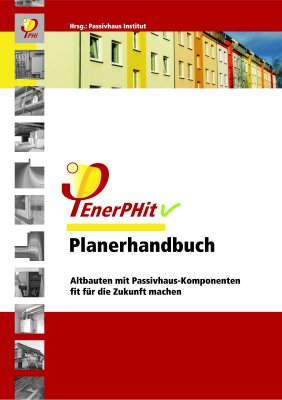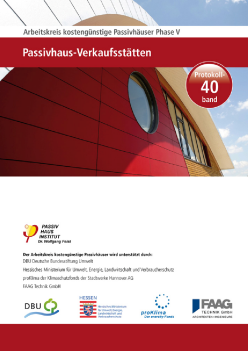Research Group for Cost-effective Passive Houses - Phase III: 2002 till 2005
The third Phase of the Research Group began in September 2002 with 8 topics (AK 21 to AK 28). In July 2004, the research Group for Cost-effective Passive Houses was extended for another year till June 2006 (AK 29 to AK 33) due to a cooperation agreement between the Ministry of the Environment of the State of Hesse (Wiesbaden), E.ON Energie AG (Munich), and LUWOGE GmbH (Ludwighafen). Since then, the Research Group has carried out first-rate work in 28 fields on developments related to cost-effective and sustainable construction providing comfortable living conditions simultaneously. The Passive House Institute in Darmstadt was entrusted with this task.
Documentation of the Research Group Sessions takes place in the form of Research Group Volume (in German) which are published by the PHI and are available for purchase.Downloads
Flyer (Research Group for Cost-effective Passive Houses), Phase III (![]() pdf 1,03 MB)
pdf 1,03 MB)
Flyer (The Passive House: comfortable and healthy living), Phase III (![]() pdf 1,35 MB)
pdf 1,35 MB)
The focus in terms of content of the Research Group for Cost-effective Passive Houses Phase III: 2002 till 2004 (AK 21 to AK 28)
After the analysis of the principle solution approaches in Phases I and II, the themes in this Phase mainly deal with improved economic efficiency of the Passive House concept. This can take place in particular through refined planning methods, use of alternative methods for construction and building services, and through extensive standardisation.
The Passive House concept is gaining relevance for the new construction sector. This is already associated with a noticeable increase in the scientific and public debates on the actual and alleged changes regarding the use of buildings. These debates must be taken up in a scientific and competent manner in order to establish the facts regarding crucial points, offer improvements to the concept in the case of justified objections, and counteract unfounded claims through education.AK 21 (23.09.2002): Sample designs: residential buildings
Nothing supports the propagation of a concept better than practice-oriented documentation of exemplary projects that have already been realised. The selected projects belong in an implementable range of construction types; they have been documented and presented in precise detail. The specific experiences gained during construction and by users were also evaluated. This was done by means of a discussion about different realised or planned Passive Houses; three projects were documented: a detached Passive House, a terraced Passive House and a Passive House multi-storey building.
During hot spells in summer, thermal comfort depends on an appropriate ventilation strategy for living spaces. In Session 22 of the Research Group various possibilities for summer ventilation were examined in detail and practical planning aids were provided for effective implementation.
AK 23 (19.03.2003): Ventilation strategy and indoor air pollutant concentration and distribution
Home ventilation is necessary mainly in order to ensure a high quality of indoor air. This is often ignored by the critics of comfort ventilation (ventilation with heat recovery) and the task is erroneously restricted to moisture protection. However, the increasing level of knowledge regarding interior analysis shows that a crucial field of work exists here (see the debate about indoor radon gas levels, for example). In this respect, different ventilation strategies lead to results that differ significantly from each other. Instructions were provided for proper planning of comfort ventilation systems in residential buildings.
AK 24 (21.05.2003): Refurbishment with Passive House components
The applicability and application limits of Passive House components in refurbishment of existing buildings were examined in Session 24 of the Research Group. While it is possible to reduce the heating demand by about a half (around 80 kWh/(m²a)) through conventional refurbishment measures for existing buildings, even more energy savings in the range of 20 to 50 kWh/(m²a) are achievable with the use of Passive House technology; it is even possible to achieve the Passive House standard (15 kWh/(m²a)) for existing buildings in some cases. Such an approach has a two-fold effect:
- Greater savings in existing buildings facilitate achievement of the targets for reductions in CO2 emissions and increase economic efficiency,
- Wide-scale application of Passive House components also in existing building refurbishment will make it possible for these to be produced in larger numbers and will thus reduces costs. Use of these components in newly built Passive Houses will also become more cost-effective due to this.
AK 25 (24.09.2003): Temperature differentiation in apartments(different rooms)
Particularly clients who have not yet experienced what it is like to live in a Passive House often tend to attach a lot of importance to separate temperature regulation for each room. Accordingly, architects and property developers are frequently confronted with questions regarding this subject. The question of the context in which such temperature differentiation becomes necessary in a Passive House and the means by which this can be realised was dealt with in depth in this Session of the Research Group.
AK 26 (17.03.2004): New Passive House building services systems with heat pumps
With heating, hot water supply and ventilation system in one unit, Passive House compact heat pump units have proven highly successful in numerous buildings and are characterised by the small amount of space required for the entire building services and the minimum effort for maintenance and installation. Compact heat pump units utilise exhaust air as a heat source and generate heat and domestic hot water. A number of other possibilities for efficient heat supply are also conceivable in addition to this, which were dealt with in Session 26:
The small heating demand of the Passive House and in particular its small heating load enable simple and cost-efficient heat distributions systems on the one hand and allow the use of easily available heat sources on the other hand. Completely new concepts become possible for devices and further opportunities for innovative developments arise as a result of this.
The latest measured results and experiences gained with Passive House compact heat pump units in Germany and Switzerland were presented within the context of Session 26 of the Research Group; test stand measurements (ISE, Freiburg and HTA Luzern) as well as field measurement results were discussed in detail.
The potential that can be accessed by using heat pumps in Passive Houses (with reference to their efficiency and costs) was analysed on the basis of different heat sources (e.g. waste water, ground under the building, air collector systems). The influence of the heat sink temperature which depends mainly on the heat transfer system was also considered.
This session highlighted the opportunities and requirements for future building services systems for Passive Houses and provided product manufacturers, planners, architects and users with valuable information in this area for planning and application of innovative and efficient heat supply systems using heat pumps.
AK 27 (10.12.2003): Heat losses through the ground
A major part of the heat loss from buildings takes place through the ground. Although a building component that is in contact with the ground loses only half the amount of heat of a similarly insulated component which is adjacent to outside air, the plinth of the building still constitutes one of the most difficult areas for the Passive House designer for reasons of statics and structural physics. It is difficult or even impossible to implement thermal bridge free base-point details, particularly when the thermal insulation has to bear increased static loads. A reliable method of calculating the respective heat losses is all the more important in this case.
In contrast with the heat losses of building components which are adjacent to the outside air, the heat loss from building components in contact with the ground is also influenced by the characteristics of the soil. Not only does multi-dimensional thermal conduction play a role here, but the effects of seasonal storage in the soil are also of importance. These effects have been described in principle by the DIN EN ISO 13370 standard; an advanced version of this standard which has been corrected and adapted to the boundary conditions for Passive Houses has already been included in the current version of the Passive House Planning Package 2003 (PHPP 2003).
Focal points of the tasks within the context of Session 27 were as follows:
- applicability of the EN 13370 standard for highly insulated buildings,
- dealing with thermal bridges,
- options and restrictions during planning of edge formwork ("aprons"),
- derivation of guidelines for positioning of subsoil heat exchanger near or under the building,
- effects on the heating load and on the heating demand of heat losses towards the ground,
- building authority approval and practical suitability of different construction materials for insulation under and on the floor slab.
AK 28 (23.06.2004): Heat transfer and distribution losses in Passive Houses
From the meanwhile numerous detailed measurements of consumption in Passive Houses, it can be shown that not only are the average energy consumptions extremely low, but also that consumptions frequently occur at values significantly below the average value corresponding with the distribution pattern.
The reasons for this distribution can mainly be found in the user-related differences in the indoor temperature. In this connection it is interesting that the low consumption values that actually occur constitute indirect proof of the extremely low transmission and distribution losses in the Passive House. These losses cannot be higher than the actual measured energy consumption, therefore rather than representing an additive constant amount, they increase in proportion to the consumption, the regulatory influence on the additional losses decreases with the lower heating demand. The interrelationships which have been qualitatively explained here were verified quantitatively within the framework of this Session of the Research Group. Information for designers and system developers was derived from this in particular for Passive House projects.
Focal points of the tasks within the context of Session 28:
- heat transmission losses solely of supply air heating
- heat distribution losses of supply air heating
- transmission and distribution losses of additional static heating surfaces, as often used in Passive Houses in the form of a bathroom heater
- transmission and distribution losses of heat supply solely by means of static heating surfaces in the Passive House
- investigation of the consequences for planning and dimensioning of the heat distribution ducts in the Passive House and the influence of regulation on the temperature gradient; derivation of recommendations for planning and project development.
The focus in terms of content of the Research Group for Cost-effective Passive Houses Phase III: 2004 till 2005 (AK 29 to AK 33)
As with the previous fields of work, research was carried out regarding the current scientific/technical situation for the given themes, problems were analysed, solutions were worked out, examples were documented, and criteria and tools were developed that could be applied in practice. The findings for each topic were publicly presented during one-day sessions of the Research Group and a Protocol Volume containing the expert contributions was published. The Protocol Volumes of the Research Group for Cost-effective Passive Houses are a substantiated source of information on state-of-the-art technology relating to energy efficient construction. A highlight of the preceding cycle was the discussion on the use of Passive House components in refurbishments of existing buildings; the respective Protocol Volume 24 sets the standard for the quality of refurbishment work in existing buildings for residential use, since it contains important information and tools for practical implementation relating to topics such as stocktaking, thermal bridge free and airtight design, quality assurance and representation of successful demonstration projects. More in-depth examination was planned particularly in the sessions concerning "Ventilation in refurbishments" and "Passive House components + interior insulation". Excellent solutions for interior insulation are an important prerequisite in many modernisation projects for which exterior insulation is not an option due to cultural, economical or design reasons. The Research Group will help to analyse experiences gained with high quality interior insulation and clarify the issues currently being debated. Highly insulated roof constructions are suitable for use in new and existing buildings; in particular, questions regarding cost optimisation and thermal bridge free and airtight connection details will be a central focus during this session. Previous Protocol Volumes have already dealt with the topic of thermal comfort in summer, whereby the main focus was on passive measures for prevention of high indoor temperatures in the summer. The session planned at the start of 2005 also dealt with energy-efficient active cooling systems in order to taken into account the extended field of application of the Passive House standard in non-residential buildings, its spread in climatic regions with hot summers and the foreseeable climate change.
AK29 (29.29.2004): Highly insulated roof constructions
The Passive House requires a particularly high standard of thermal protection of all exterior wall components in general as well as for connection details. The roof plays a special role here due to its high proportion of area; additional heat transmission occurs here especially in accommodation units on the top floor of multi-storey buildings.
Smaller insulation thicknesses in the roof are sufficient in order to fulfil the heating criterion in multi-storey constructions. One question that is frequently asked is whether the heating loads occurring in top floor apartments with a high proportion of exterior surface are critical. A systematic examination of the heating loads occurring in a top floor apartment was carried out in this session. Besides consideration of the heating load, the heat transfer processes at the surface of the roof in different types of surfaces were also studied and their effect on thermal comfort in summer was discussed.
In the practical part, roof constructions were presented and evaluated with reference to their level of insulation and costs. The focus was on simple solutions for highly insulated roofs.
The roof/exterior wall connection is significant in respect of airtightness as well as thermal bridges. Depending on the type of construction, there is often a change of material at this point (e.g. solid construction/lightweight roof structure). Optimised concepts for airtightness and thermal bridge free connections were presented.
Practice-oriented, highly insulated roof constructions and connection details were presented. The optimisation of such constructions in terms of energy efficiency and cost-effectiveness was the central theme of this session.
AK 30 (01.12.2004): Ventilation in refurbishments
Home ventilation is an essential prerequisite for the use of Passive House technology in existing buildings as well. Retrofitting buildings with a home ventilation system using conventional technology is sometimes very difficult, which is the reason why many planners void using this method for existing buildings, although this is associated with considerable advantages, especially with regard to indoor air quality and protection of the building substance.
It is therefore especially important to examine good and practicable solutions for retrofitting of existing buildings with highly efficient home ventilation systems even in difficult conditions.
A comparative examination of different approaches took place during the relevant preliminary research project:
- Centrally located solutions with optimised routing of ducts
- Room-by-room, decentrally arranged solutions with small devices integrated into walls or insulation,
- Group solutions with devices which supply several rooms at a time
Special attention was given to practical application (noise emission, draughts), but also issues relating to short-circuiting of air flows, electrical efficiency and highly efficient heat recovery were discussed.
AK 31 (09.03.2005): Energy efficient cooling
In Germany, in the past buildings were built mostly without any active cooling systems; these were usually not necessary for reasons of comfort. It is only with modern constructions (mostly large glazing areas) and the greater number of internal heat sources, as well as the increasingly noticeable effects of climate change that space cooling has become a task that must be technically planned.
Passive technology can contribute significantly towards solving this problem; in the case of residential buildings, these can usually make extensive active cooling unnecessary in Passive Houses. This topic was dealt with in Sessions 15 and 22 of the Research Group and planning tools for dimensioning of such passive technology were provided.
If very high internal heat gains are present in non-residential buildings, solely passive technology will eventually reach its limits and the financial effort required for this will be very high even earlier. In some ways the situation can be compared to the progression of the heating demand with an increasingly better level of insulation - decreasing the heating demand to zero is often unacceptable economically; this is also unnecessary because the already existing technology (in this case the home ventilation system) can also undertake the heating task with very little extra effort if the Passive House limit of < 10 W/m² is adhered to. A similar effect is expected for space cooling - this too can be undertaken simultaneously by the ventilation system as long as certain criteria, which are still to be defined, are adhered to. The question of the provision of cooling energy from passive sources or with the help of an efficient conventional refrigerator generally plays a secondary role also in the case of space cooling; as for the case of space heating, what matters is that the solutions applied are reliable, uncomplicated and cost-efficient and that the primary energy demand for these is reasonably small. This must be so small that it becomes possible to meet the Passive House primary energy criteria.
It was the task of the Research Group to examine the different possibilities for cooling and respective dimensioning for Passive Houses (especially for office buildings).
AK 32 (18.05.2005): Factor 4 reduction for sensitive retrofits
In Session 24 it was recognised that that Passive House components offer a significant potential for energy-efficient refurbishments. Since then, this potential has been impressively implemented in practice by means of a demonstration project by the FAAG development association in Frankfurt which was scientifically monitored with funding by the State of Hesse. Established technology for Passive House suitable exterior insulation was used in this session well as for the demonstration project. Exterior insulation has a whole range of structural and practical advantages for construction. In addition, except for a few details, it allows for thermal bridge free construction in existing buildings and for effective insulation thicknesses, so that the Passive House standard can be achieved in refurbished buildings too (with the exception of ground floors).
However, in a significant number of existing buildings, thermal insulation on the outside is not possible. This applies in particular for listed historical buildings, but also for buildings with high-value visible facades or other permanent exterior surfaces which do not require any measures other than cleaning. In the last-mentioned cases, exterior insulation is not an option mainly due to economic reasons.
It already became apparent in Session 24 that even in these cases modernisation using Passive House components in combination with interior insulation can open up considerable efficiency potentials, enabling a heating demand of between 40 and 60 kWh/(m²a); although this will not result in achievement of the Passive House standard, it is still an improvement by a factor of 4 compared with average existing buildings.
In the preliminary research project for this Session (keyword: interior insulation):
- the actual potential was ascertained using typical example projects,
- generally applicable solutions with the minimum possible thermal bridges were defined for specific connection points for interior insulation (at least for intersections of interior walls, ceilings, window reveals)
- solutions were developed for prevention of moisture damage
- solutions were identified for airtightness in refurbishments with interior insulation
AK33 (20./21.10.2005): Passive House schools
The Passive House standard has now been realised and proved in numerous residential building projects during the last 15 years. The Passive House standard for schools is still new, but it offers several advantages especially due to the high occupancy rates in classrooms. As a central element of the Passive House standard, the use of mechanical ventilation is extremely worthwhile solely for indoor air hygiene reasons. Measurements of the indoor air quality have shown that sufficient air exchange and thus adequate air quality in classrooms could only be achieved by means of controlled ventilation. In Germany, about 870 construction measures are carried in schools each year (average for years 1991 to 2000), of which 370 were for new school constructions. Thus many opportunities for energy-efficient and sustainable buildings are possible.
Order Research Group Volume online (in German)
| Next Courses |
PHPP Expert
Passive House Designer / Consultant
Construction Verifier
Site Supervisor
![]() read more
read more
e-learning
| Events |
iPHA Webinar | "Project Spotlight: Vancouver Passive House Policy and the Fire Hall 17" | May 8, 2024
![]() read more
read more
![]() Passive House Open Days |
Passive House Open Days |
28 - 30 June 2024
![]() read more
read more
| Component Database |
 Passive House
Passive House
Component Database
read more
| Projects |
| New developments |
![]() designPH
designPH
read more
![]() NEW: PHPP 10 (2021)
NEW: PHPP 10 (2021)
read more
 Seals for Certified Passive House Components
Seals for Certified Passive House Components
read more
 Passive House Classes,
Passive House Classes,
Classic, Plus, Premium
read more
 EnerPHit -
EnerPHit -
PHI certification for retrofits
read more
 Wall plaque
Wall plaque
for certified Passive Houses
read more
| Press releases |
| Research & Literature |
![]() Passive Houses for different climate zones
Passive Houses for different climate zones
more
 Retrofits with Passive House components -
Retrofits with Passive House components -
EnerPHit Planner Handbook
(in German)
 Passive House Retail Stores now out
Passive House Retail Stores now out
Overview of contents
(in German)

